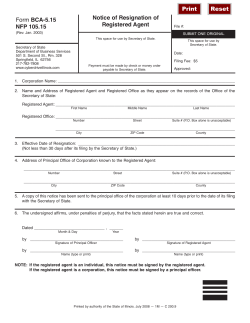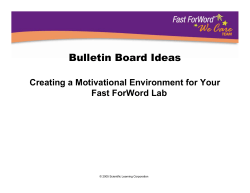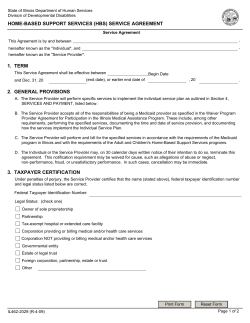
SOA design patterns and principles
SOA design patterns and principles © Copyright IBM Corporation 2006 Course materials may not be reproduced in whole or in part without the prior written permission of IBM. 4.0.3 4.0.3 Unit objectives After completing this unit, you should be able to: ● Describe various design principles that can be applied during service design within SOA ● Define SOI and describe patterns and principles that can be applied towards developing SOI architecture ● Define ESB and explain its role in SOI ● Describe IBM’s patterns for e-business and the process for applying these patterns ● Describe SOA runtime patterns such as ESB, ESB Gateway, Business Service Choreography, Business Service Directory ● Explain the SOA Application patterns such as the Direct Connection, Broker, Serial Process, and Parallel Process, plus their variations and their realization using runtime patterns © Copyright IBM Corporation 2006 Role of patterns in SOA Foundation Governance and Process • SOA Center of Excellence • Rational Unified Process (RUP) • IT Infrastructure Library (ITIL) Best Practices • SOA-Related IP • Patterns • Redbooks • Engagement Experience © Copyright IBM Corporation 2006 Education • Introduction to Value and Governance Model of SOA • Web services for managers • Technologies and Standards for SOA Project Implementation • Design SOA Solutions and Apply Governance Service design principles ● Re-use ● Encapsulation ● Well-defined interfaces – High cohesion – Meaningful names for operations (semantic operations) – Operational granularity ● Statelessness ● Efficient resource utilization © Copyright IBM Corporation 2006 Re-use ●Concept – A service interface should be designed with reuse in mind ●Consequences – Well factored service interfaces: • Anticipate usage scenarios, and consequently facilitate reuse – Poorly factored service interfaces: • Hinder reuse and encourage functional duplication, which can result in architectural decay (loss of architectural integrity over time) © Copyright IBM Corporation 2006 Encapsulation ● Concept – Services should not physically expose any implementation details or deployment details at their interface design. ● Consequences: – Well encapsulated services: • • Benefit adaptability by decoupling the service implementation characteristics and service deployment characteristics from the client implementation. In circumstances where an implementation specific or a deployment specific characteristic needs to be changed, then the client remains unaffected. – Poorly encapsulated services: • • Hinder adaptability as a consequence of coupling the client with the service implementation characteristics or service deployment characteristics. In circumstances where an implementation specific or a deployment specific characteristic needs to be changed, then both the client implementation and the service implementation need to be changed. © Copyright IBM Corporation 2006 Well-defined service interfaces ● High cohesion - Concept – Services interfaces should be concise, related, and complete sets of operations. ● Consequences: – Cohesive services: • Provide every operation required by and appropriate for the consumer. – Un-cohesive services: • Hinder consumability – cause confusion by exposing tenuously related, or unrelated, operations to the consumer. ● Operational parameter granularity - Concept – Service operation parameters should be coarse grained, and allied to the operation semantics. • As coarse-grained as possible whilst maintaining semantic integrity. ● Consequences: – Coarse-grained parameter lists: • Benefit consumability and comprehension with concise and semantic signatures. – Fine-grained parameter lists: • Burden consumability and comprehension with clumsy, verbose signatures, resulting in difficult to read code. ● Semantic operations - Concept – Services, operations, and operation parameters, should use language that conveys the meaning of the operations to the consumer, and should represent the operation's actions. ● Consequences: – Well named services: • Benefit understanding by service consumers because they imply the service semantics or behaviour. – Poorly named services: • Burden comprehension and degrade semantic integrity. © Copyright IBM Corporation 2006 Statelessness ● Concept – Service implementations should not hold conversational state across multiple requests. • Communicate complete information at each request. – Each operation should be functionally isolated (separate, independent). ● Consequences: – Stateless and connectionless services: • Benefit adaptability owing to the independence that exists between a client's successive service requests and the service instance that fulfils each request. – This is an enabler for improved runtime qualities (for example, service request throughput or concurrent service requests) via pooling and sharing of service instances (that is, client-service independence). – Stateful services: • Hinder adaptability as a consequence of tight dependency (coupling) between a clients successive service requests – There is then a need for a specific service instance to fulfil a particular request (that is, client-service affinity). © Copyright IBM Corporation 2006 Efficient resource utilization ●Concept – Service implementations should be optimistic, brief and courteous with resource usage. ●Consequences: – Optimistic (loosely-coupled) resource usage: • Facilitate higher system performance qualities; concurrency, scalability and availability, through courteous use of resources. – Pessimistic (tightly-coupled) resource usage: • Hinder higher system performance qualities through resource monopolisation and obstruction; locking and blocking. © Copyright IBM Corporation 2006 Service-oriented integration defined Service-oriented integration (SOI) is defined as integrating computing entities using only service interactions in a service-oriented architecture (SOA). ●An architectural style which integrates service providers and service consumers through looselycoupled services. – Changes to clients and service providers can be made independently from each other. – New protocols and interfaces can be integrated and supported quickly without impacting the service consumer. ●A programming model complete with standards, tools and technologies such as Web Services. © Copyright IBM Corporation 2006 SOI principles – loose-coupling ●Services are loosely-coupled when changes to several aspects do not affect the consumers of the service. ●Tighter coupling tends to cost more over time: – Synchronizing multiple organizations on change. – Adapting, changing or redeploying updated components without affecting others. – Difficult to move, to scale, to distribute, and to replace. – More coupling implies more complex testing. ●Looser coupling requires greater investment up front: – More design work. – More implementation work. © Copyright IBM Corporation 2006 Several service elements must be considered when thinking about coupling: Service Message Interface Contract Policy Conversation State Transactions Loose-coupling aspects of service interactions Location Language Data Format Delivery Assurance Interaction Semantic State Interface Consumer Platform Decoupled Provider Protocol Time Security Service Version ? © Copyright IBM Corporation 2006 Service Provider Identity Business Data Model Coupled What is an enterprise service bus? So what does this really mean for architecting an ESB? An ESB powers your SOA by reducing the number, size, and complexity of interfaces. An ESB performs the following between requestor and service • ROUTING messages between services • CONVERTING transport protocols between requestor and service • TRANSFORMING message formats between requestor and service • HANDLING business events from disparate sources Shape = Protocol Color = Data type © Copyright IBM Corporation 2006 ESB – enabler for SOI into this Turn this Service Service Interface Service Service Interface Interface Service Service Service Service Enterprise Service Bus Interface Interface Interface Interface Service Service Service Service 9 Decouples the point-topoint connections from the interfaces. 9 9 Allows for dynamic selection, substitution, and matching. Service Service 9 Enables more flexible coupling and decoupling of the applications. Service Enables you to find both the applications and the interfaces for re-use. Result Æ Greater business responsiveness © Copyright IBM Corporation 2006 Service ESB role in SOI – service virtualization ● ESB acts as an intermediary (proxy) between requestor and provider. ● ESB provides service virtualization of: – Location and identity – Interaction protocol – Interface ● Interactions are decoupled, supporting separation of concerns. © Copyright IBM Corporation 2006 Enterprise service bus reference architecture Interaction, Process, Information, Partner, Business App, Access Services Interaction, Process, Information, Partner, Business App, Access Services Business Logic Enterprise Service Bus Interaction Patterns Message Flows Message Flows Mediation Patterns Message MessageModels Models Transport TransportProtocols Protocols Security Management IT Management Services © Copyright IBM Corporation 2006 Registry ESB capabilities – functions and features ● Ubiquitous and heterogeneous –Universal connectivity –For example, J2EE, .NET, Cobol ● Leverage existing investments –CICS, IMS, legacy –WBI and other services Adaptors and connectors ● Mediations –Transformation –Validation –Pattern Recognition –Customized Routing –Subsidiary functions (for example, metering and policy integration) ● Virtualization of services –Dynamic selection of service providers –Flexible management of QoS ● Explicit intermediary –Proxy for non-enterprise connections –Security control-point ● Service Management –Security and access control –Registry and discovery –Monitoring and policy-based admin ● Standards-based –Interoperability with business partners, including security –Vendor-independence ● Tools –Ability to deploy, manage, update, access thousands of services –Ability to intuitively create BPEL linked to Business processes –Export of WSDL interface definitions for partners’ use –Enterprise apps invoking Web Services © Copyright IBM Corporation 2006 IBM patterns vision – application integration ● A set of tooled pattern language families and “recipes” covering Service Design and Development for end-to-end solutions Access Integration Self-Service Collaboration Information Aggregation Application Integration Patterns for e-business SMB/Enterprise Grain Patterns and Industry Solutions Extended Enterprise (Management Integration) Micro Grain Patterns – Design Patterns/J2EE UML2/MOF Language Foundation © Copyright IBM Corporation 2006 Patterns for e-business – overview ● The patterns for e-business extend the domain of software patterns to earlier phases of the application development life cycle. – Maximize impact on key design decisions made early in the development cycle. ● Patterns for e-business help you to do the following: – Understand and analyze complex business problems and break them down into smaller, more manageable functions. – Capture and publish e-business artifacts that have been used, tested, and proven to be successful. – Speed up the solution development and integration process through documented and proven architectural constructs. – Assemble an end-to-end solution (and minimize custom one-of-a-kind implementations). – Apply expert knowledge to projects with teams that are new to ebusiness development. © Copyright IBM Corporation 2006 Process for applying patterns for e-business ● Capture customer requirements – Standard RUP activity, generates use cases. ● Fit-gap analysis and generic use-cases – The Business Analyst or Software Architect decides which generic use-cases apply. ● Select SOA Entry point scenarios (next unit) – Using these generic use-cases the Business Analyst or Software Architect matches against the corresponding scenarios. ● Re-use patterns assets to accelerate the solution architecture – Exploit the patterns associated with the previously identified scenarios to architect your SOA solution. Discussed next. ● Select the relevant implementation guide © Copyright IBM Corporation 2006 Application and runtime patterns defined Application Architecture Call Prog A Infrastructure Architecture Prog B Deploy Deploy AppServer 1 Call ESB Call AppServer 2 ● Application patterns are used to design application architectures. – They show the levels of detail of interest at the business or developer level. ● Application patterns are mapped (‘deployed’) onto runtime patterns. Runtime patterns are used to design infrastructure architectures. © Copyright IBM Corporation 2006 SOA runtime pattern family External Service Consumers Internal Service Consumers Business Service Choreography Enterprise Service Bus ESB Gateway External Service Providers Routing, transformation, mediations, security, and so forth Internal Service Providers Infrastructure components for SOA © Copyright IBM Corporation 2006 ESB Namespace Directory Business Service Directory SOA runtime pattern family – service consumers and producers External Service Consumers Internal Service Consumers Business Service Choreography Enterprise Service Bus ESB Gateway External Service Providers Routing, transformation, mediations, security, and so forth Internal Service Providers Infrastructure components for SOA © Copyright IBM Corporation 2006 ESB Namespace Directory Business Service Directory SOA runtime pattern family – ESB and ESB Gateway External Service Consumers Internal Service Consumers Business Service Choreography Enterprise Service Bus ESB Gateway External Service Providers Routing, transformation, mediations, security, and so forth Internal Service Providers Infrastructure components for SOA © Copyright IBM Corporation 2006 ESB Namespace Directory Business Service Directory SOA runtime pattern family – business service choreography External Service Consumers Internal Service Consumers Business Service Choreography Enterprise Service Bus ESB Gateway External Service Providers Routing, transformation, mediations, security, and so forth Internal Service Providers Infrastructure components for SOA © Copyright IBM Corporation 2006 ESB Namespace Directory Business Service Directory SOA runtime pattern family – Business Service Directory External Service Consumers Internal Service Consumers Business Service Choreography Enterprise Service Bus ESB Gateway External Service Providers Routing, transformation, mediations, security, and so forth Internal Service Providers Infrastructure components for SOA © Copyright IBM Corporation 2006 ESB Namespace Directory Business Service Directory SOA Process Integration application patterns Parallel Process Variation: Parallel WorkFlow Focus: Adds joining, splitting, and so forth of multiple series of operations on multiple targets Yes T1 Serial Process Mgr S T2 S Parallel Process Mgr T1 T3 T2 T3 No Serial Interaction Serial Process Variation: Serial WorkFlow Focus: Single series of operations on multiple targets Direct Connection Variations: Message/Call Connection Focus: Sending messages on a single path to a single target Direct Connector S Broker Variation: Router Focus: Adds switching, routing, splitting, joining messages on multiple paths to multiple targets T1 T S Broker T2 T3 No Parallel Interaction © Copyright IBM Corporation 2006 Yes Direct Connection ESB interaction patterns Message Connection Consumer ESB Provider Call Connection (asynchronous or synchronous) Consumer ESB © Copyright IBM Corporation 2006 Provider Broker ESB interaction patterns Router variation ESB Request Service A Consumer Provider of Service A Router Mediation Provider of Service B Broker variation ESB Consumer Service A Request Service A Response Broker Mediation © Copyright IBM Corporation 2006 Provider 1 of Service A Provider 2 of Service A Serial and Parallel Process ESB interaction patterns Consumer ESB1 Locate or Create Customer BSC ESB1 Process Rules ESB1 Credit Check ESB2 Open Account ● The Business Service Choreography (BSC) component works together with the ESB to provide both mediation and process orchestration features (focus of this course). © Copyright IBM Corporation 2006 Unit summary Having completed this unit, you should be able to: ● Describe various design principles that can be applied during service design within SOA ● Define SOI and describe patterns and principles that can be applied towards developing SOI architecture ● Define ESB and explain its role in SOI ● Describe IBM’s patterns for e-business and the process for applying these patterns ● Describe SOA Runtime patterns such as ESB, ESB Gateway, Business Service Choreography, Business Service Directory ● Explain the SOA Application patterns such as the Direct Connection, Broker, Serial Process, Parallel Process, plus their variations and their realization using runtime patterns © Copyright IBM Corporation 2006
© Copyright 2025





















